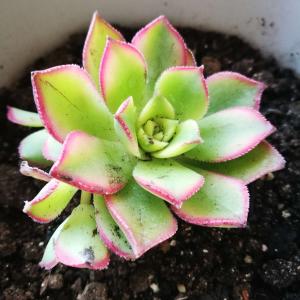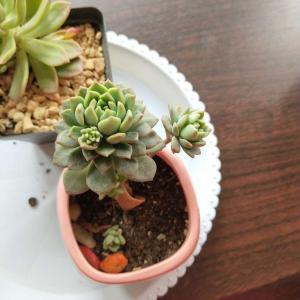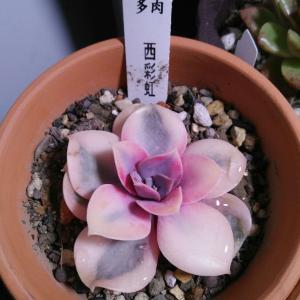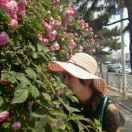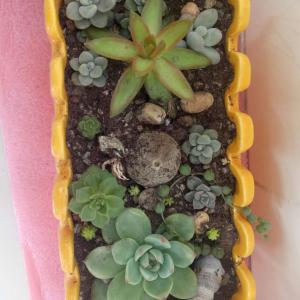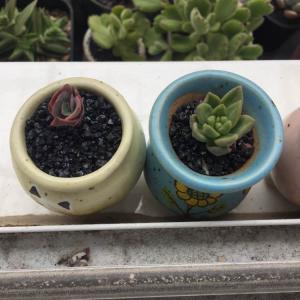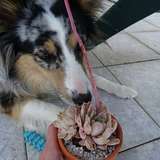文章
Miss Chen
2018年04月05日

Description: This perennial herbaceous plant is 1¼–4' tall, producing either solitary or multiple leafy stems from the same root system. The stems are light green, reddish green, or light to medium brown; they are terete and sparsely to moderately short-pubescent. Abundant alternate leaves occur along each stem that become gradually smaller in size as they ascend. The leaf blades are 1-4" long and ¼–1" across; they are elliptic to broadly elliptic, or lanceolate-elliptic, or oblanceolate-elliptic in shape. The margins of leaf blades are entire (toothless) to slightly toothed toward their tips and they are short-ciliate. The upper blade surface is yellowish green or medium green and sparsely covered with minute stiff hairs, providing it with a slightly rough texture; the lower blade surface is light to medium green and glabrous to short-pubescent along the major veins. The leaf blades are either sessile or they have short petioles. Each stem terminates in a cylindrical panicle of flowerheads about 4-10" long. The branches and peduncles of the panicle are light green and more or less covered with short hairs that are usually glandular. Leafy bracts up to 1" long and ¼" across occur along these branches and at the bases of peduncles; these bracts are similar in appearance to the leaves, except they are smaller in size. Individual flowerheads are about 6 mm. (¼") long and 3-4 mm. across.
Each flowerhead has 5-10 ray florets that surround a dense head of 8-20 disk florets. The ray florets are pistillate (female), while the disk florets are perfect (both male and female). The spreading petaloid rays of the flowerhead are golden yellow and narrowly oblong in shape. The tubular corollas of the disk florets are yellow and they have 5 narrow lobes along their upper rims. The base of each flowerhead has a cylindrical urn-shape that is tapered at its base; it is surrounded by phyllaries (floral bracts) in about 4 overlapping series. The phyllaries are light green, linear-lanceolate in shape, and either minutely pubescent or glandular-pubescent (usually the latter); these phyllaries are strongly recurved toward their tips. The blooming period occurs from late summer to mid-autumn, lasting about 3-4 weeks. Afterwards, the florets are replaced by achenes with small tufts of hair; they are distributed by the wind. The bodies of these achenes are about 3 mm. long, bullet-shaped, and either glabrous or slightly short-pubescent. The root system is fibrous and sometimes long-rhizomatous; an older plant usually develops a swollen caudex. This plant spreads by reseeding itself or it can form clonal offspring from rhizomes.

Cultivation: The preference is partial sun, mesic to dry conditions, and a somewhat acidic soil containing rocky material or sand. This plant will adapt to cultivation, however it may require staking to prevent it from toppling over.
Range & Habitat: Downy Ragged Goldenrod is native to southern Illinois, where it is uncommon, while elsewhere within the state it is absent (see Distribution Map). Illinois lies along the northern range-limit of this plant; it occurs primarily in south-central and southeast USA. Habitats include upland woodlands, upland savannas, thinly wooded rocky bluffs, thickets, glades with acidic bedrock, and rocky prairies. In the wooded habitats where this plant occurs, they are typically dominated by oaks and hickories. Outside of Illinois, Downy Ragged Goldenrod also occurs in sandy mixed woodlands (where both hardwood deciduous trees and conifers are present). This plant is normally found in high quality natural areas. Occasional wildfires are probably beneficial in maintaining its populations.

Faunal Associations: Very little is known about the floral-faunal relationships of Downy Ragged Goldenrod specifically. This goldenrod is a significant source of nectar for migrating Monarch butterflies in Arkansas (Rudolph et al., 2006) and the larvae of a leaf beetle, Microrhopala excavata, mine its leaves (Clark et al., 2004). For goldenrods (Solidago spp.) in general, the nectar and pollen of the flowerheads attract a wide variety of insects, including honeybees, bumblebees, little carpenter bees (Ceratina spp.), leaf-cutter bees (Megachile spp.), Halictid bees, masked bees (Hylaeus spp.), Andrenid bees, wasps, Syrphid flies and other flies, butterflies, skippers, and beetles. Several Andrenid bees are oligoleges (specialist pollinators) of goldenrods; this includes Andrena hirticincta, Andrena nubecula, Andrena placata, Andrena simplex, and Andrena solidaginis. In addition, a plasterer bee, Colletes simulans armata, is an oligolege of goldenrods. A wide variety of insects feed destructively on the foliage, flowerheads, stems, roots, and plant juices of various goldenrods. These species include leaf beetles (Microrhopala spp., Ophraella spp., Trirhabda spp.), larvae of leaf-miner flies (Calycomyza spp.), larvae of gall flies (Asteromyia spp., Rhopalomyia spp.), plant bugs (Lygus spp., Polymerus spp., Slaterocoris spp.), Corythucha marmorata (Goldenrod Lace Bug), aphids (Uroleucon spp.), treehoppers (Stictocephala spp.), Aonidomytilus solidaginis (Goldenrod Scale), larvae of Gelechiid moths (Dichomeris spp.), larvae of Schinia nundina (Goldenrod Flower Moth) and other Noctuid moths, larvae of Tortricid moths (Epiblema spp., Eucosma spp., Phaneta spp.), and grasshoppers (Melanoplus spp.); see Clark et al. (2004), Spencer & Steyskal (1986), Felt (1917), Aldrich & Osten-Sacken (1905), Knight (1941), Watson (1928), Wheeler et al. (1983), Cranshaw (2004), Hottes & Frison (1931), Blackman & Eastop (2013), Dennis (1952), Covell (1984/2005), Miller (1987), and Vickery & Kevan (1985) for more information. Vertebrate animals use goldenrods as a source of food to a more limited extent. The seeds of these plants are eaten by such birds as the Indigo Bunting, American Goldfinch, Slate-colored Junco, and Tree Sparrow; the Greater Prairie Chicken feeds on the foliage and flowerheads (DeVore et al., 2004; Martin et al., 1951/1961; Yeatter, 1943). Occasionally, the White-tailed Deer and Cottontail Rabbit also feed on the young foliage of goldenrods (Sotala & Kirkpatrick, 1973; Martin et al., 1951/1961). These plants are a source of food for the Prairie Vole (Cole & Batzli, 1979) and probably other voles.

Photographic Location: The wildflower garden of the webmaster in Urbana, Illinois.
Comments: Sometimes this species is called 'Downy Goldenrod.' There is some variability in the width of leaves, presence of teeth on the leaves, abundance of pubescence, and presence of glandular hairs on this goldenrod across its range. Downy Ragged Goldenrod (Solidago petiolaris) is easy to identify in Illinois because of the recurved phyllaries (floral bracts) of its flowerheads; this is the only goldenrod within the state that has this characteristic, and it is rare among goldenrods (Solidago spp.) elsewhere. One species with this characteristic is Stout Goldenrod (Solidago squarrosa). This latter species is found primarily in northeastern United States. Stout Goldenrod has larger lower leaves than Downy Ragged Goldenrod (Solidago petiolaris), and its lower leaves have more teeth. Overall, it is a less hairy plant than Downy Ragged Goldenrod. The remaining goldenrod with recurved phyllaries, Wright's Goldenrod (Solidago wrightii), is difficult to distinguish from Downy Ragged Goldenrod. Because Wright's Goldenrod occurs some distance away in the southwestern area of the United States, it won't be considered any further.
Each flowerhead has 5-10 ray florets that surround a dense head of 8-20 disk florets. The ray florets are pistillate (female), while the disk florets are perfect (both male and female). The spreading petaloid rays of the flowerhead are golden yellow and narrowly oblong in shape. The tubular corollas of the disk florets are yellow and they have 5 narrow lobes along their upper rims. The base of each flowerhead has a cylindrical urn-shape that is tapered at its base; it is surrounded by phyllaries (floral bracts) in about 4 overlapping series. The phyllaries are light green, linear-lanceolate in shape, and either minutely pubescent or glandular-pubescent (usually the latter); these phyllaries are strongly recurved toward their tips. The blooming period occurs from late summer to mid-autumn, lasting about 3-4 weeks. Afterwards, the florets are replaced by achenes with small tufts of hair; they are distributed by the wind. The bodies of these achenes are about 3 mm. long, bullet-shaped, and either glabrous or slightly short-pubescent. The root system is fibrous and sometimes long-rhizomatous; an older plant usually develops a swollen caudex. This plant spreads by reseeding itself or it can form clonal offspring from rhizomes.

Cultivation: The preference is partial sun, mesic to dry conditions, and a somewhat acidic soil containing rocky material or sand. This plant will adapt to cultivation, however it may require staking to prevent it from toppling over.
Range & Habitat: Downy Ragged Goldenrod is native to southern Illinois, where it is uncommon, while elsewhere within the state it is absent (see Distribution Map). Illinois lies along the northern range-limit of this plant; it occurs primarily in south-central and southeast USA. Habitats include upland woodlands, upland savannas, thinly wooded rocky bluffs, thickets, glades with acidic bedrock, and rocky prairies. In the wooded habitats where this plant occurs, they are typically dominated by oaks and hickories. Outside of Illinois, Downy Ragged Goldenrod also occurs in sandy mixed woodlands (where both hardwood deciduous trees and conifers are present). This plant is normally found in high quality natural areas. Occasional wildfires are probably beneficial in maintaining its populations.

Faunal Associations: Very little is known about the floral-faunal relationships of Downy Ragged Goldenrod specifically. This goldenrod is a significant source of nectar for migrating Monarch butterflies in Arkansas (Rudolph et al., 2006) and the larvae of a leaf beetle, Microrhopala excavata, mine its leaves (Clark et al., 2004). For goldenrods (Solidago spp.) in general, the nectar and pollen of the flowerheads attract a wide variety of insects, including honeybees, bumblebees, little carpenter bees (Ceratina spp.), leaf-cutter bees (Megachile spp.), Halictid bees, masked bees (Hylaeus spp.), Andrenid bees, wasps, Syrphid flies and other flies, butterflies, skippers, and beetles. Several Andrenid bees are oligoleges (specialist pollinators) of goldenrods; this includes Andrena hirticincta, Andrena nubecula, Andrena placata, Andrena simplex, and Andrena solidaginis. In addition, a plasterer bee, Colletes simulans armata, is an oligolege of goldenrods. A wide variety of insects feed destructively on the foliage, flowerheads, stems, roots, and plant juices of various goldenrods. These species include leaf beetles (Microrhopala spp., Ophraella spp., Trirhabda spp.), larvae of leaf-miner flies (Calycomyza spp.), larvae of gall flies (Asteromyia spp., Rhopalomyia spp.), plant bugs (Lygus spp., Polymerus spp., Slaterocoris spp.), Corythucha marmorata (Goldenrod Lace Bug), aphids (Uroleucon spp.), treehoppers (Stictocephala spp.), Aonidomytilus solidaginis (Goldenrod Scale), larvae of Gelechiid moths (Dichomeris spp.), larvae of Schinia nundina (Goldenrod Flower Moth) and other Noctuid moths, larvae of Tortricid moths (Epiblema spp., Eucosma spp., Phaneta spp.), and grasshoppers (Melanoplus spp.); see Clark et al. (2004), Spencer & Steyskal (1986), Felt (1917), Aldrich & Osten-Sacken (1905), Knight (1941), Watson (1928), Wheeler et al. (1983), Cranshaw (2004), Hottes & Frison (1931), Blackman & Eastop (2013), Dennis (1952), Covell (1984/2005), Miller (1987), and Vickery & Kevan (1985) for more information. Vertebrate animals use goldenrods as a source of food to a more limited extent. The seeds of these plants are eaten by such birds as the Indigo Bunting, American Goldfinch, Slate-colored Junco, and Tree Sparrow; the Greater Prairie Chicken feeds on the foliage and flowerheads (DeVore et al., 2004; Martin et al., 1951/1961; Yeatter, 1943). Occasionally, the White-tailed Deer and Cottontail Rabbit also feed on the young foliage of goldenrods (Sotala & Kirkpatrick, 1973; Martin et al., 1951/1961). These plants are a source of food for the Prairie Vole (Cole & Batzli, 1979) and probably other voles.

Photographic Location: The wildflower garden of the webmaster in Urbana, Illinois.
Comments: Sometimes this species is called 'Downy Goldenrod.' There is some variability in the width of leaves, presence of teeth on the leaves, abundance of pubescence, and presence of glandular hairs on this goldenrod across its range. Downy Ragged Goldenrod (Solidago petiolaris) is easy to identify in Illinois because of the recurved phyllaries (floral bracts) of its flowerheads; this is the only goldenrod within the state that has this characteristic, and it is rare among goldenrods (Solidago spp.) elsewhere. One species with this characteristic is Stout Goldenrod (Solidago squarrosa). This latter species is found primarily in northeastern United States. Stout Goldenrod has larger lower leaves than Downy Ragged Goldenrod (Solidago petiolaris), and its lower leaves have more teeth. Overall, it is a less hairy plant than Downy Ragged Goldenrod. The remaining goldenrod with recurved phyllaries, Wright's Goldenrod (Solidago wrightii), is difficult to distinguish from Downy Ragged Goldenrod. Because Wright's Goldenrod occurs some distance away in the southwestern area of the United States, it won't be considered any further.
0
0
文章
Miss Chen
2018年04月05日

Description: This herbaceous perennial wildflower overwinters as a rosette of semi-evergreen leaves. Beginning in mid- to late spring, it bolts to become about 1¼–3' tall by autumn. The central stem is light green (sometimes with streaks of light purple), terete, evenly short-pubescent, erect to ascending, and mostly unbranched, although short secondary stems often develop from the upper leaf axils. Alternate leaves occur along the entire length of the central stem, becoming gradually smaller as they ascend. Individual leaves are 1¼–3¼" long and 1–2¾" across (about 1.2–2 times as long as wide); they are ovate to broadly ovate with rather flattened serrated teeth along their margins. The tips of the leaves are broadly acute, while their bases taper somewhat abruptly to short winged petioles. The winged margins of the petioles are widest where they join the leaf blades, but disappear where they join the stems. The upper leaf surface is medium to dark green and sparsely short-hairy to nearly glabrous, while the lower leaf surface is light green and sparsely to moderate short-pubescent. The lower leaf surface is more pubescent along the undersides of major veins than between the veins. Leaf venation is pinnate with a prominent central vein; 2 prominent lateral veins are present on some leaves but not others.
The central stem terminates in a pyramidal panicle of flowerheads that is up to 1¼' long and 1' across; the panicle is usually widest toward the lower bottom. In response to the weight of this inflorescence, there is a tendency for the entire plant to arch to one side. Relative to the orientation of the central branch of the panicle, the lateral branches are mostly ascending or ascending-arching. The branchlets terminating in flowerheads are up to 1/3" (8 mm.) long and they bend upward to hold the flowerheads in an erect position, regardless of the orientation of the panicle. Both the branches and branchlets of the inflorescence are light to medium green, terete, and densely short-pubescent. Interspersed along the branches of the inflorescence are leafy bracts up to 1" long and ¾" across; the leafy bracts are oval, broadly elliptic, obovate, or ovate in shape, while their margins are toothless. Along the terminal branchlets, there are a few leafy bractlets up to 1/8" (3 mm.) long that are green, broadly oblong in shape, and scale-like in appearance. Both the leafy bracts and leafy bractlets are medium to dark green and densely short-pubescent along their lower sides. The flowerheads (including both their involucres and florets) are about ¼" (5-6 mm.) tall and ¼" (5-6 mm.) across. Each flowerhead has 4-7 disk florets that are surrounded by 4-6 ray florets. The corollas of the disk florets are yellow and short-tubular in shape with 5 arching lobes at their apices. The petaloid rays of the ray florets are yellow, widely spreading and short-oblong in shape with 1 or 2 shallow notches at their tips. The base of each flowerhead is surrounded by scale-like phyllaries (floral bracts) in about 3 irregular series. These phyllaries are unequal in size, light green, oblong with rounded or bluntly acute tips, and appressed to together; their margins are short-ciliate. Both the disk florets and ray florets are perfect.

The blooming period occurs during early to mid-autumn, lasting about one month. Much smaller and sparsely branched panicles of flowerheads may bloom from short leafy stems that develop from the axils of the upper leaves. Fertile florets are replaced by small achenes with sessile tufts of white hair; they are distributed by the wind. The achenes are about 1.5–2 mm. long and narrowly bullet-shaped. The root system consists of a short branching rootstock, sometimes forming a small caudex on older robust plants. Sometimes clonal plants are produced from short stout rhizomes.
Cultivation: The preference is full sun to moderate shade, moist to dry conditions, and calcareous soil containing clay, loam, or rocky material. This uncommon goldenrod, notwithstanding its restricted range, adapts readily to flower gardens in a variety of situations.
Range & Habitat: The native Drummond's Goldenrod is restricted to the border counties of southwest Illinois, where it is uncommon (see Distribution Map). This goldenrod is a Midwestern endemic plant that is found primarily in Missouri and Arkansas. Habitats include borders of wooded bluffs, openings in rocky wooded bluffs, limestone glades, ledges and tops of limestone cliffs, and crevices of limestone cliffs. The bluffs and cliffs are typically located along rivers (the Mississippi River in the case of Illinois). This conservative species is found primarily in high quality natural areas.

Faunal Associations: Very little information is available about floral-faunal relationships for Drummond's Goldenrod. However, goldenrods (Solidago spp.) in general attract a wide variety of insects to their flowerheads. This includes honeybees, bumblebees, cuckoo bees (Epeolus spp.), leaf-cutter bees (Megachile spp.), long-horned bees (Melissodes spp.), little carpenter bees (Ceratina spp.), green metallic bees (Augochlorella spp.), Halictid bees (Halictus spp., Lasioglossum spp.), plasterer bees (Colletes spp.), masked bees (Hylaeus spp.), Andrenid bees (Andrena spp.), dagger bees (Perdita spp., Heterosarus spp.), ground beetles (Lebia spp.), ladybird beetles (Hippodamia spp.), Sphecid wasps, Vespid wasps, Tiphiid wasps, Syrphid flies, bee flies (Bombyliidae), Tachinid flies, flesh flies (Sarcophaga spp.), blow flies (Lucilia spp.), Muscid flies, butterflies, and day-flying moths (Robertson, 1929, & others). Other insects feed on the leaves, plant juices, and other parts of goldenrods. The larvae of a leaf beetle, Microrhopala excavata, have been observed to mine the leaves of Drummond's Goldenrod. Other insect feeders of goldenrods include other leaf beetles (Ophraella spp., Trirhabda spp.), larvae of leaf-mining flies (Calycomyza spp.), larvae of gall flies (Asteromyia spp., Rhopalomyia spp.), plant bugs (Lygus spp., Plagiognathus spp., Slaterocoris spp.), stink bugs (Euschistus spp.), aphids (Uroleucon spp.), treehoppers (Stictocephala spp.), grasshoppers (Melanoplus spp.), larvae of owlet moths (Cucullia spp.), larvae of Geometer moths (various species), and larvae of Tortrix moths (Epiblema spp., Eucosma spp., Phaneta spp.). Among vertebrate animals, the seeds of goldenrods are eaten by such songbirds as the Eastern Goldfinch, Slate-colored Junco, Tree Sparrow, and Indigo Bunting (Martin et al., 1951/1961; DeVore et al., 2004). The White-tailed Deer and Cottontail Rabbit sometimes feed on the foliage of these plants, while the Woodland Vole and other voles feed on both the foliage and seeds (Martin et al., 1951/1961).

Photographic Location: The wildflower garden of the webmaster in Urbana, Illinois.
Comments: This is one of the best goldenrods (Solidago spp.) for ornamental gardens. It should be cultivated more often. Drummond's Goldenrod resembles many other goldenrod species, but it can be distinguished as follows: 1) the leaves of Drummond's Goldenrod are unusually wide, sometimes they are almost as wide as they are across, 2) the leafy bracts of the inflorescence of Drummond's Goldenrod are also unusually wide, 3) its stems are evenly short-pubescent, rather than hairless or hairy in longitudinal lines, 4) the phyllaries, or floral bracts, of its flowerheads have either bluntly acute or rounded tips, 5) the branches of the terminal inflorescence spread rather widely, and 6) the habitats of this goldenrod are largely restricted to riverside bluffs, limestone glades, and limestone cliffs. Of the preceding characteristics, #1 and #6 above are the most distinctive. Some authors state that the leaves of this goldenrod have 3 prominent veins (a central vein and 2 lateral veins) – while this is true for some leaves, not all leaves have this characteristic.
The central stem terminates in a pyramidal panicle of flowerheads that is up to 1¼' long and 1' across; the panicle is usually widest toward the lower bottom. In response to the weight of this inflorescence, there is a tendency for the entire plant to arch to one side. Relative to the orientation of the central branch of the panicle, the lateral branches are mostly ascending or ascending-arching. The branchlets terminating in flowerheads are up to 1/3" (8 mm.) long and they bend upward to hold the flowerheads in an erect position, regardless of the orientation of the panicle. Both the branches and branchlets of the inflorescence are light to medium green, terete, and densely short-pubescent. Interspersed along the branches of the inflorescence are leafy bracts up to 1" long and ¾" across; the leafy bracts are oval, broadly elliptic, obovate, or ovate in shape, while their margins are toothless. Along the terminal branchlets, there are a few leafy bractlets up to 1/8" (3 mm.) long that are green, broadly oblong in shape, and scale-like in appearance. Both the leafy bracts and leafy bractlets are medium to dark green and densely short-pubescent along their lower sides. The flowerheads (including both their involucres and florets) are about ¼" (5-6 mm.) tall and ¼" (5-6 mm.) across. Each flowerhead has 4-7 disk florets that are surrounded by 4-6 ray florets. The corollas of the disk florets are yellow and short-tubular in shape with 5 arching lobes at their apices. The petaloid rays of the ray florets are yellow, widely spreading and short-oblong in shape with 1 or 2 shallow notches at their tips. The base of each flowerhead is surrounded by scale-like phyllaries (floral bracts) in about 3 irregular series. These phyllaries are unequal in size, light green, oblong with rounded or bluntly acute tips, and appressed to together; their margins are short-ciliate. Both the disk florets and ray florets are perfect.

The blooming period occurs during early to mid-autumn, lasting about one month. Much smaller and sparsely branched panicles of flowerheads may bloom from short leafy stems that develop from the axils of the upper leaves. Fertile florets are replaced by small achenes with sessile tufts of white hair; they are distributed by the wind. The achenes are about 1.5–2 mm. long and narrowly bullet-shaped. The root system consists of a short branching rootstock, sometimes forming a small caudex on older robust plants. Sometimes clonal plants are produced from short stout rhizomes.
Cultivation: The preference is full sun to moderate shade, moist to dry conditions, and calcareous soil containing clay, loam, or rocky material. This uncommon goldenrod, notwithstanding its restricted range, adapts readily to flower gardens in a variety of situations.
Range & Habitat: The native Drummond's Goldenrod is restricted to the border counties of southwest Illinois, where it is uncommon (see Distribution Map). This goldenrod is a Midwestern endemic plant that is found primarily in Missouri and Arkansas. Habitats include borders of wooded bluffs, openings in rocky wooded bluffs, limestone glades, ledges and tops of limestone cliffs, and crevices of limestone cliffs. The bluffs and cliffs are typically located along rivers (the Mississippi River in the case of Illinois). This conservative species is found primarily in high quality natural areas.

Faunal Associations: Very little information is available about floral-faunal relationships for Drummond's Goldenrod. However, goldenrods (Solidago spp.) in general attract a wide variety of insects to their flowerheads. This includes honeybees, bumblebees, cuckoo bees (Epeolus spp.), leaf-cutter bees (Megachile spp.), long-horned bees (Melissodes spp.), little carpenter bees (Ceratina spp.), green metallic bees (Augochlorella spp.), Halictid bees (Halictus spp., Lasioglossum spp.), plasterer bees (Colletes spp.), masked bees (Hylaeus spp.), Andrenid bees (Andrena spp.), dagger bees (Perdita spp., Heterosarus spp.), ground beetles (Lebia spp.), ladybird beetles (Hippodamia spp.), Sphecid wasps, Vespid wasps, Tiphiid wasps, Syrphid flies, bee flies (Bombyliidae), Tachinid flies, flesh flies (Sarcophaga spp.), blow flies (Lucilia spp.), Muscid flies, butterflies, and day-flying moths (Robertson, 1929, & others). Other insects feed on the leaves, plant juices, and other parts of goldenrods. The larvae of a leaf beetle, Microrhopala excavata, have been observed to mine the leaves of Drummond's Goldenrod. Other insect feeders of goldenrods include other leaf beetles (Ophraella spp., Trirhabda spp.), larvae of leaf-mining flies (Calycomyza spp.), larvae of gall flies (Asteromyia spp., Rhopalomyia spp.), plant bugs (Lygus spp., Plagiognathus spp., Slaterocoris spp.), stink bugs (Euschistus spp.), aphids (Uroleucon spp.), treehoppers (Stictocephala spp.), grasshoppers (Melanoplus spp.), larvae of owlet moths (Cucullia spp.), larvae of Geometer moths (various species), and larvae of Tortrix moths (Epiblema spp., Eucosma spp., Phaneta spp.). Among vertebrate animals, the seeds of goldenrods are eaten by such songbirds as the Eastern Goldfinch, Slate-colored Junco, Tree Sparrow, and Indigo Bunting (Martin et al., 1951/1961; DeVore et al., 2004). The White-tailed Deer and Cottontail Rabbit sometimes feed on the foliage of these plants, while the Woodland Vole and other voles feed on both the foliage and seeds (Martin et al., 1951/1961).

Photographic Location: The wildflower garden of the webmaster in Urbana, Illinois.
Comments: This is one of the best goldenrods (Solidago spp.) for ornamental gardens. It should be cultivated more often. Drummond's Goldenrod resembles many other goldenrod species, but it can be distinguished as follows: 1) the leaves of Drummond's Goldenrod are unusually wide, sometimes they are almost as wide as they are across, 2) the leafy bracts of the inflorescence of Drummond's Goldenrod are also unusually wide, 3) its stems are evenly short-pubescent, rather than hairless or hairy in longitudinal lines, 4) the phyllaries, or floral bracts, of its flowerheads have either bluntly acute or rounded tips, 5) the branches of the terminal inflorescence spread rather widely, and 6) the habitats of this goldenrod are largely restricted to riverside bluffs, limestone glades, and limestone cliffs. Of the preceding characteristics, #1 and #6 above are the most distinctive. Some authors state that the leaves of this goldenrod have 3 prominent veins (a central vein and 2 lateral veins) – while this is true for some leaves, not all leaves have this characteristic.
0
0
文章
Miss Chen
2018年04月05日

Description: This herbaceous perennial plant is 1-2½' tall and unbranched. The central stem is stout, smooth, and zigzags slightly. It usually reclines to the side somewhat, rather than being held stiffly erect with respect to the ground. The alternate leaves are narrowly ovate, with parallel veins and smooth margins. They are up to 6" long and 2" across, and are sessile to the central stem, or have short petioles. The undersides of the leaves may be slightly pubescent.
The central stem terminates in a single inflorescence consisting of small white flowers. This inflorescence is a narrow raceme (almost spike-like) about 1-4" long. Each flower has 6 narrow tepals, 6 stamens with yellow anthers, and a central pistil that is shaped like a vase with a long, narrow neck. When fully open, each star-like flower is about 1/3" across. The blooming period occurs during late spring and lasts about 3 weeks. There is a mild floral fragrance. Each flower is replaced by a small berry about ¼" across. The berries are initially green with purple or black stripes, but later become bright red. The root system consists of stout rhizomes, which form vegetative colonies readily.
Cultivation: This plant prefers moist to slightly dry conditions and partial sunlight. It will also tolerate light shade and full sunlight. It is not particular about soil texture, but often grows in sandy soil in native habitats. Insects and disease are rarely bothersome.

Range & Habitat: Starry False Solomon's Seal occurs occasionally in northern and east-central Illinois; it is uncommon to absent elsewhere within the state (see Distribution Map). This wildflower is native to Illinois. Habitats include sandy prairies, moist meadows in woodland areas, woodland borders, sandy riverbanks and semi-wooded slopes, Black Oak savannas, calcareous seeps, and the shrub zone of sand dunes near Lake Michigan. Among the Smilacina spp. in Illinois, Starry False Solomon's Seal is the most likely to occur in sunny areas, although it usually doesn't stray far from areas with some woody vegetation.
Faunal Associations: The flowers attract Halictid bees (including Green Metallic bees), flower flies, and Tachinid flies primarily. These insects seek nectar or pollen. The berries are eaten by woodland songbirds, including various woodland thrushes and the Veery, as well as the White-Footed Mouse. These animals help to distribute the seeds. Deer often feed on the foilage, cropping the stems to about 6" above the ground.

Photographic Location: The photograph was taken near Busey Woods in Urbana, Illinois.
Comments: Starry False Solomon's Seal has attractive foilage, flowers, and berries. It can be distinguished from Smilacina racemosa (False Solomon's Seal) by the narrower leaves and spike-like inflorescence. The latter plant has a plume-like inflorescence that consists of a spreading raceme. Another plant with similar foliage, Polygonatum biflorum (Smooth Solomon's Seal), has broader leaves that are pale green. However, the flowers of this species occur in pairs underneath the leaves along the stem. Another scientific name for Starry False Solomon's Seal is Maianthemum stellatum.
The central stem terminates in a single inflorescence consisting of small white flowers. This inflorescence is a narrow raceme (almost spike-like) about 1-4" long. Each flower has 6 narrow tepals, 6 stamens with yellow anthers, and a central pistil that is shaped like a vase with a long, narrow neck. When fully open, each star-like flower is about 1/3" across. The blooming period occurs during late spring and lasts about 3 weeks. There is a mild floral fragrance. Each flower is replaced by a small berry about ¼" across. The berries are initially green with purple or black stripes, but later become bright red. The root system consists of stout rhizomes, which form vegetative colonies readily.
Cultivation: This plant prefers moist to slightly dry conditions and partial sunlight. It will also tolerate light shade and full sunlight. It is not particular about soil texture, but often grows in sandy soil in native habitats. Insects and disease are rarely bothersome.

Range & Habitat: Starry False Solomon's Seal occurs occasionally in northern and east-central Illinois; it is uncommon to absent elsewhere within the state (see Distribution Map). This wildflower is native to Illinois. Habitats include sandy prairies, moist meadows in woodland areas, woodland borders, sandy riverbanks and semi-wooded slopes, Black Oak savannas, calcareous seeps, and the shrub zone of sand dunes near Lake Michigan. Among the Smilacina spp. in Illinois, Starry False Solomon's Seal is the most likely to occur in sunny areas, although it usually doesn't stray far from areas with some woody vegetation.
Faunal Associations: The flowers attract Halictid bees (including Green Metallic bees), flower flies, and Tachinid flies primarily. These insects seek nectar or pollen. The berries are eaten by woodland songbirds, including various woodland thrushes and the Veery, as well as the White-Footed Mouse. These animals help to distribute the seeds. Deer often feed on the foilage, cropping the stems to about 6" above the ground.

Photographic Location: The photograph was taken near Busey Woods in Urbana, Illinois.
Comments: Starry False Solomon's Seal has attractive foilage, flowers, and berries. It can be distinguished from Smilacina racemosa (False Solomon's Seal) by the narrower leaves and spike-like inflorescence. The latter plant has a plume-like inflorescence that consists of a spreading raceme. Another plant with similar foliage, Polygonatum biflorum (Smooth Solomon's Seal), has broader leaves that are pale green. However, the flowers of this species occur in pairs underneath the leaves along the stem. Another scientific name for Starry False Solomon's Seal is Maianthemum stellatum.
0
0



